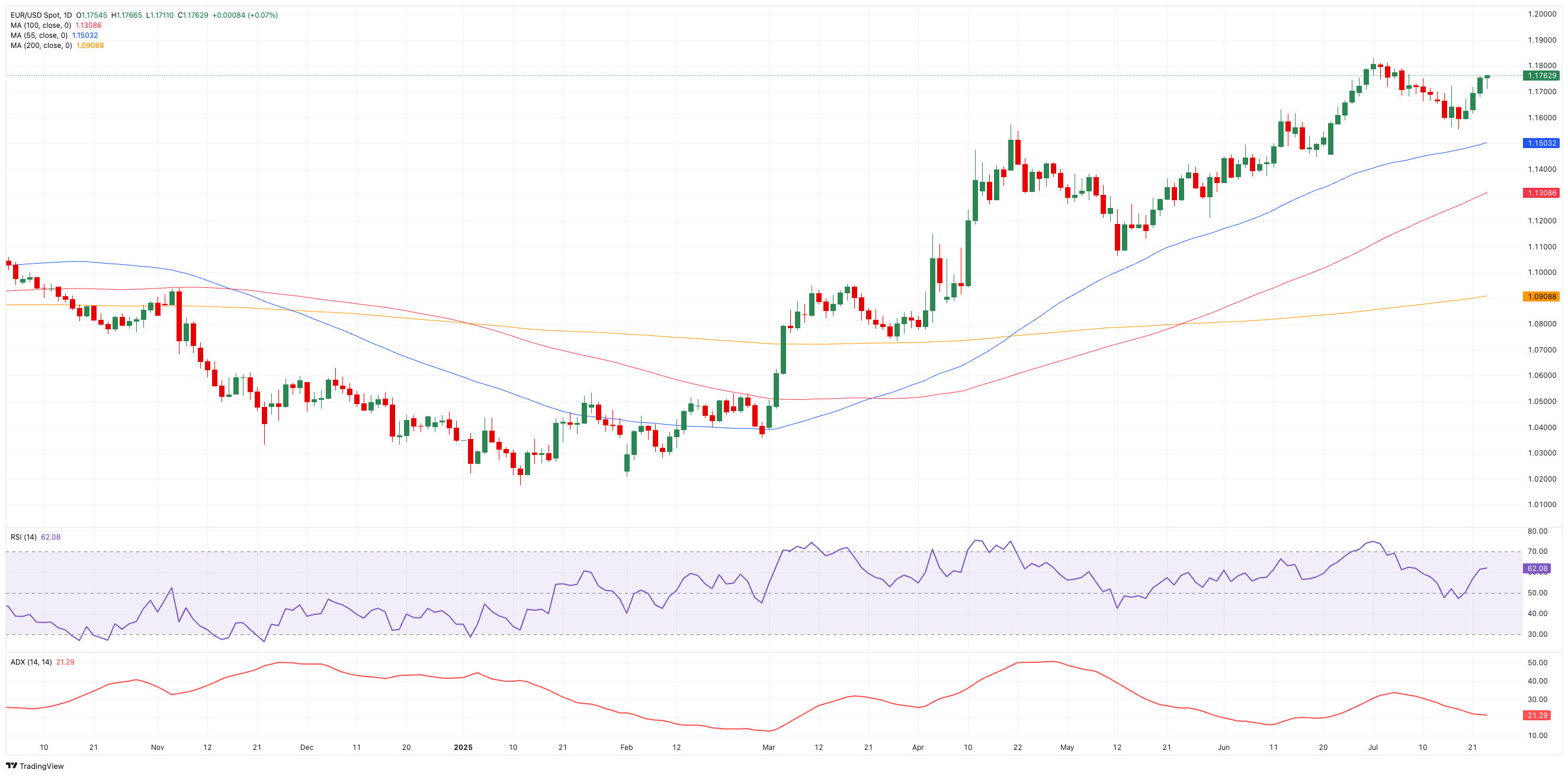
- EUR/USD rose to two-week highs near 1.1770 in quite a volatile session.
- The US Dollar receded marginally based on improved sentiment around trade.
- The ECB meets on Thursday and is expected to keep rates unchanged.
The Euro (EUR) managed to advance marginally on Wednesday, enough to keep the positive streak in EUR/USD alive for the fourth day in a row.
The small uptick mirrored a humble pullback in the US Dollar Index (DXY), knocked lower by extra improvements on the trade front, while questions over Federal Reserve independence remained in place.
Tariff clock keeps ticking
Pushing Washington’s next tariff decision to August 1 has soothed no one.
However, the recent clinched US-Japan trade deal provided some respite for global markets, and the progress on a potential US-EU deal has invigorated the risk complex.
Brussels, anticipating deadlock, is dusting off “anti‑coercion” tools that could limit US service access or bar American firms from EU tenders if talks fail. Should a deal prove elusive, President Trump has warned that Europe will be directly targeted.
Diverging central‑bank scripts
The FOMC Minutes from the June gathering revealed a house divided: some policymakers back swift cuts; others want to see how tariff‑driven inflation plays out. A June CPI uptick bolstered Chair Jerome Powell’s wait‑and‑see stance, though futures still pencil in modest easing later this year.
In Frankfurt, the European Central Bank (ECB) trimmed its deposit rate to 2.00% in early June and signalled that any fresh stimulus will depend on clearer signs of softening external demand.
The majority of traders, in the meantime, expect the Governing Council to stick to that cautious line when it meets later on Thursday, keeping the key rates unchanged.
Positioning split: specs long, hedgers short
CFTC data to July 15 show speculators swelling EUR longs to around 128.2K contracts, the heftiest bet since December 2023. Commercial players, meanwhile, have gone the other way, expanding net shorts to nearly 184.2K contracts, the biggest hedge in months. Additionally, open interest has climbed for four weeks to just over 820K contracts, the highest level since March 2023.
Charts in focus
A decisive climb above the 2025 peak at 1.1830 (July 1) would clear the way for a potential test of the June 2018 high at 1.1852 (Jun 14).
Conversely, slipping below the July base at 1.1556 (July 17) could draw the pair toward the transitory 55‑day SMA at 1.1501, the weekly low at 1.1210 (May 29), and ultimately the psychological 1.1000 mark.
Momentum has improved but remains tentative, with the Relative Strength Index (RSI) beyond 62, and the Average Directional Index (ADX) around 22.
EUR/USD daily chart

What could sway the tide
The Euro’s rally is unfolding against a backdrop of tariff jitters and a widening policy gap between the Fed and the ECB. A softer tone from Washington on trade—or a hint of flexibility from the Fed—could turbocharge sentiment in favour of the single currency. Until then, bulls are likely to keep one eye on 1.1830 and the other on the tariff clock.
ECB FAQs
The European Central Bank (ECB) in Frankfurt, Germany, is the reserve bank for the Eurozone. The ECB sets interest rates and manages monetary policy for the region. The ECB primary mandate is to maintain price stability, which means keeping inflation at around 2%. Its primary tool for achieving this is by raising or lowering interest rates. Relatively high interest rates will usually result in a stronger Euro and vice versa. The ECB Governing Council makes monetary policy decisions at meetings held eight times a year. Decisions are made by heads of the Eurozone national banks and six permanent members, including the President of the ECB, Christine Lagarde.
In extreme situations, the European Central Bank can enact a policy tool called Quantitative Easing. QE is the process by which the ECB prints Euros and uses them to buy assets – usually government or corporate bonds – from banks and other financial institutions. QE usually results in a weaker Euro. QE is a last resort when simply lowering interest rates is unlikely to achieve the objective of price stability. The ECB used it during the Great Financial Crisis in 2009-11, in 2015 when inflation remained stubbornly low, as well as during the covid pandemic.
Quantitative tightening (QT) is the reverse of QE. It is undertaken after QE when an economic recovery is underway and inflation starts rising. Whilst in QE the European Central Bank (ECB) purchases government and corporate bonds from financial institutions to provide them with liquidity, in QT the ECB stops buying more bonds, and stops reinvesting the principal maturing on the bonds it already holds. It is usually positive (or bullish) for the Euro.
Information on these pages contains forward-looking statements that involve risks and uncertainties. Markets and instruments profiled on this page are for informational purposes only and should not in any way come across as a recommendation to buy or sell in these assets. You should do your own thorough research before making any investment decisions. FXStreet does not in any way guarantee that this information is free from mistakes, errors, or material misstatements. It also does not guarantee that this information is of a timely nature. Investing in Open Markets involves a great deal of risk, including the loss of all or a portion of your investment, as well as emotional distress. All risks, losses and costs associated with investing, including total loss of principal, are your responsibility. The views and opinions expressed in this article are those of the authors and do not necessarily reflect the official policy or position of FXStreet nor its advertisers. The author will not be held responsible for information that is found at the end of links posted on this page.
If not otherwise explicitly mentioned in the body of the article, at the time of writing, the author has no position in any stock mentioned in this article and no business relationship with any company mentioned. The author has not received compensation for writing this article, other than from FXStreet.
FXStreet and the author do not provide personalized recommendations. The author makes no representations as to the accuracy, completeness, or suitability of this information. FXStreet and the author will not be liable for any errors, omissions or any losses, injuries or damages arising from this information and its display or use. Errors and omissions excepted.
The author and FXStreet are not registered investment advisors and nothing in this article is intended to be investment advice.








